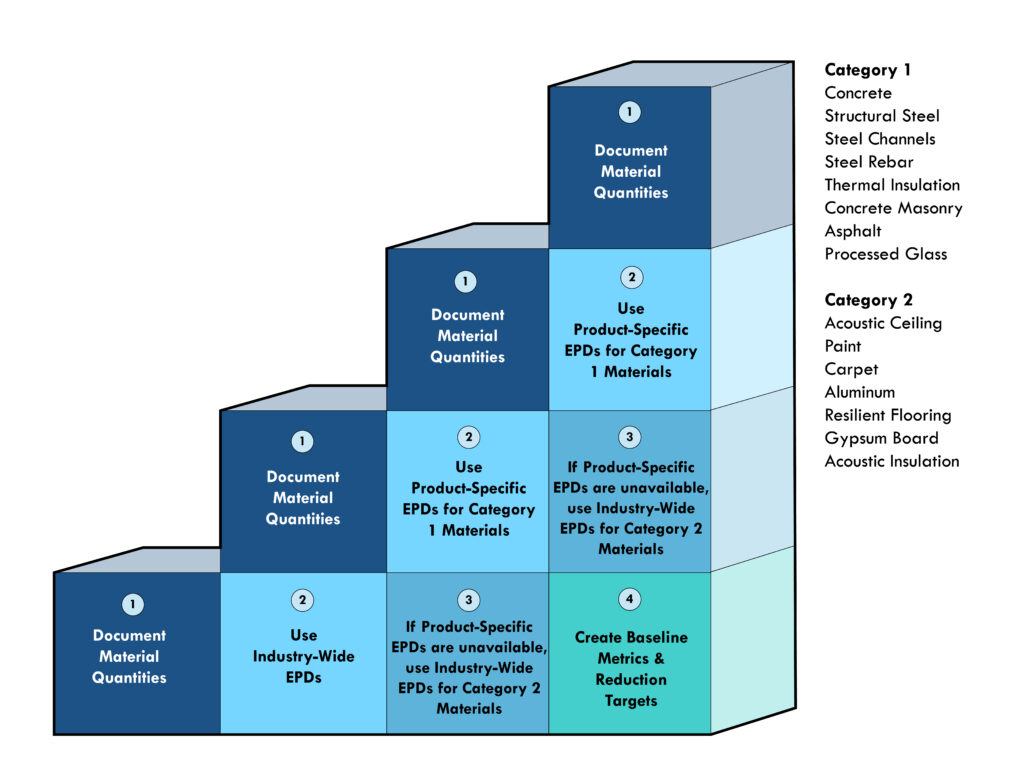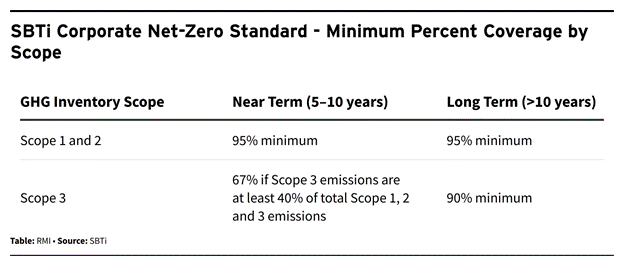
A Primer on Embodied Carbon in Climate Disclosure
Introduction
Climate disclosure has become a primary focus of investors and governments seeking to understand climate impacts and risks associated with businesses. California recently enacted a first-in-the-nation law that will require large companies operating in the state to disclose their annual greenhouse gas emissions, including Scope 3 impacts. This historic development will increase emphasis on the depth and accuracy of corporate climate disclosure.
In parallel, there has been significant growth in voluntary investor demand for environmental, social, and governance (ESG)–oriented assets. ESG reporting allows investors and lenders to assess a firm’s ability to provide higher long-term returns alongside its plans to address social equity, sustainability, and climate risk. According to a 2022 report by PwC, ESG-focused institutional investment is projected to grow 84% by 2026, making up 21.5% of assets under management.
The shift in investor preference and regulatory policy has created value for businesses that steer toward climate-aligned objectives, while highlighting challenges inherent to tracking and measuring greenhouse gas (GHG) emissions. Companies that adopt robust emissions reporting practices will attract investment and reduce risk as more governments move to adopt climate disclosure mandates.
In the real estate industry, streamlined integration of embodied carbon reporting into Scope 3 climate disclosure practices can drive more transformative investments to reduce up-front GHG emissions from building materials and construction. Accounting for embodied carbon emissions supports market development for low-carbon materials, design services, and circular economy businesses across the real estate industry value chain. This primer on embodied carbon in climate disclosure lays out the what, why, and how to simplify this topic for real estate stakeholders.
What Is Climate Disclosure?
Climate disclosure refers to the practice of businesses reporting their GHG emissions footprint as well as their assessment of risks posed by climate change. The Greenhouse Gas Protocol (GHG Protocol) is the framework most widely used by businesses to categorize and report emissions impact. The Task Force for Climate-Related Financial Disclosures provides resources to guide climate risk assessment. Under this GHG Protocol, emissions are organized into Scope 1, Scope 2, and Scope 3 categories. Scopes 1 and 2 include direct and indirect emissions from sources controlled by the business, while Scope 3 emissions include a range of indirect impacts resulting from parts of the value chain the business does not control.
The Case for Scope 3 Climate Disclosure in Real Estate
The real estate sector is not immune to climate disclosure trends. According to CBRE, a leading global real estate services provider, 60% of respondents to its Global Investor Intentions Survey stated that they have adopted ESG criteria.
In the real estate industry, conversations on carbon emissions reporting and reduction have traditionally focused on operational energy performance of buildings. For real estate developers, the owners, lessors, and lessees of energy-efficient buildings reduce operational costs and mitigate Scope 1 and 2 emissions. Scope 1 and 2 net-zero carbon commitments are increasingly common among leading lease occupiers and real estate development firms.
However, Scope 3 emissions reporting remains piecemeal, with investors and real estate firms choosing a varying subset of Scope 3 categories to include in their climate disclosure strategies. Among the Scope 3 categories, reporting on embodied emissions from building materials and construction remains a major gap for the real estate sector.
At the asset level, embodied carbon for a new building project can account for up to 50% of the total carbon footprint over its life cycle. This share can be even higher for energy-efficient or zero-energy buildings. According to the CDP, capital goods comprise 49% of the real estate sector’s GHG emissions impact, as shown in Exhibit 1. Although building materials may not account for all these emissions, they are certainly a major contributor in a building development-, construction-, and renovation-focused industry. Real estate developers who are committed to reducing their environmental impact and meeting climate-aligned targets should account for and reduce embodied carbon.
Exhibit 1 Real Estate Sector – Characterization of Scope 3 Impacts
Scope 3 in the Investor Landscape
Another compelling reason for the real estate industry to take action to measure and reduce embodied carbon emissions is that it will attract increased support from investors already asking for more accurate measurement and reporting of Scope 3 emissions. Although there is a lack of consistent reporting on embodied carbon emissions for Scope 3 emissions tracking, the real estate industry can expect to see increased investor demand for transparency on this issue.
Several major ESG-minded investors and organizations, including the following, are asking for Scope 3 accounting from companies in which they invest:
- BlackRock, the world's largest asset manager, has been increasingly focused on ESG issues in recent years. The company is currently asking companies to disclose their Scope 3 emissions as part of its engagement efforts.
- State Street Global Advisors, another of the largest asset managers in the world, has also been advocating for Scope 3 accounting. As early as 2020, the company published a report urging companies to disclose their Scope 3 emissions and set targets for reducing them.
- California Public Employees' Retirement System (also known as CalPERS) is one of the largest public pension funds in the world and has made a large push for Scope 3 accounting. In 2018, the fund announced that it would be requiring companies in its portfolio to disclose their Scope 3 emissions.
Beyond voluntary reporting requests by large investors, regulatory bodies are taking action on climate-related ESG disclosures. Due to the recognized variability and imprecision of definitions that have created confusion among investors, the Securities and Exchange Commission (SEC) announced an effort to standardize climate-related disclosures for investors, indicating that ESG statements will be more heavily scrutinized. In parallel, the International Sustainability Standards Board was formed to standardize globally applicable sustainability-related ESG reporting requirements.
The SEC rule under consideration would require reporting of all Scope 1 and 2 emissions and material Scope 3 emissions for publicly traded companies. Given the relative impact of embodied carbon from construction as a fraction of the real estate industry’s climate footprint, these emissions should be included as a reported Scope 3 category. Real estate firms should familiarize themselves with embodied carbon emissions tracking today to stay ahead of the curve as climate disclosure makes its way into financial regulation.
How to Report on Embodied Carbon in Real Estate Industry Climate Disclosure
Leading real estate businesses have started to report Scope 3 emissions associated with building materials as part of their climate disclosures; however, their approach has been varied due to the lack of consistent guidance on the topic and the evolving data ecosystem. These companies’ efforts offer preliminary case studies on existing approaches to portfolio-wide reporting of embodied carbon that can inform improved practices in the industry. At a high level, there are two factors that determine a company’s approach to embodied carbon emissions accounting.
Scope 3 Embodied Emissions Categorization
The first factor is the categorization of embodied carbon emissions from construction materials among the GHG Protocol Scope 3 categories. For building developers and owners, embodied carbon emissions associated with building projects fall primarily in the purchased goods and capital goods emissions categories, with ancillary impacts captured in other categories. However, there is variation in how different businesses categorize these emissions depending on their internal procurement process and categorization of their assets. Based on definitions from the GHG Protocol and a review of leading real estate firms’ approaches to Scope 3 building materials emissions reporting, we developed the categorization scheme outlined in Exhibits 2 and 3 for embodied carbon reporting in the real estate industry:

Exhibit 3 Embodied Carbon Disclosure Categorization Schema
Mass-Based Embodied Emissions Accounting
The second factor in embodied carbon emissions accounting is the calculation methodology used to account for these emissions. To date, companies have used a spend-based method, which quantifies emissions per unit of currency and is only a proxy for GHG emissions. These calculations result in inaccuracies in the estimations of embodied carbon emissions. As such, companies should move toward mass-based emissions calculations, where material quantities are calculated and used alongside emissions data from environmental product declarations (EPDs) or reputable life-cycle inventory (LCI) databases. Mass-based emissions are more accurate representations of the climate impact of building materials.
Only the A1–A3, that is, extraction through manufacturing, life-cycle phases should be pulled from EPDs for the purposes of up-front emissions tracking. In addition, use of facility- or product-specific EPDs is recommended for major building materials, such as concrete, steel, processed glass, asphalt, and insulation. Where facility- or product-specific EPDs are not available, industry-wide EPDs may be used. Where EPDs are not available, and for other building material categories, representative data from third-party LCI databases, such as OneClick LCA, Athena Impact Estimator, Tally, or SimaPro, may be used. Exhibit 4 describes a pathway to improving the quality of embodied carbon emissions accounting for the real estate industry.

Although the mass-based approach should be used to underpin embodied carbon emissions calculations, we recommend that data is logged at the building or project level through whole-project life-cycle assessment (LCA). This will aid in understanding up-front emissions (A1–A3) relative to other life-cycle impacts, establish benchmarks, and support tracking of embodied carbon through a building’s life span.
A building’s life span typically extends through multiple owners and tenants, with their respective interventions. Long-term embodied carbon emissions accounting for the real estate industry can be undertaken through material passports, which transfer data from as-built whole-building LCA to tracking logs that can be managed throughout the asset’s life span. Tools such as these can create value in the real estate industry by establishing buildings as material banks. They will make it easier to incentivize material circularity and account for end-of-life impacts associated with buildings, which should be documented when an owner sells a building as part of GHG Protocol Scope 3, Category 12: End-of-life treatment of sold products.
The Path to Zero
Once real estate companies have adopted policies to track and report Scope 3 embodied carbon emissions, the next step is setting targets to reduce this climate impact over time.
Many organizations have chosen to adopt net-zero commitments to buttress their ESG agenda based on guidance from the Science Based Targets initiative (SBTi). SBTi actively has more than 3,000 companies globally using their standards as a baseline for decarbonization. A company is considered to have reached net zero when it has achieved its long-term science-based target. Exhibit 5 describes the SBTi net-zero standard.
 RMI Graphic. Source: SBTi, https://sciencebasedtargets.org/resources/files/Net-Zero-Standard.pdf
RMI Graphic. Source: SBTi, https://sciencebasedtargets.org/resources/files/Net-Zero-Standard.pdfSBTi is in the process of developing guidance on accounting methodologies and a climate-aligned pathway for embodied carbon in buildings. A preliminary draft of the guidance is available, while a refined iteration is planned for release in fall 2023.
For real estate firms interested in mapping embodied carbon emissions–reduction pathways to zero by 2050, we encourage you to read RMI’s Roadmap to Reaching Zero Embodied Carbon in Federal Building Projects, which maps trajectories to zero for the US federal buildings portfolio. Exhibit 6 outlines the pathways to zero developed for this roadmap.
Exhibit 6 GHG Emissions from US Federal Building Projects to 2050, Pathways to Zero Carbon
RMI Graphic. Source: RMI Federal Embodied Carbon Roadmap
Momentum is building for the real estate industry to address embodied carbon, with a cross section of firms reporting initiatives on the topic, such as:
- Performing case study LCAs to evaluate embodied carbon in redevelopment projects;
- Requiring embodied carbon assessments in all new building and adaptive reuse projects; and
- Establishing mass-based low-embodied-carbon material procurement and tracking practices for high-volume materials, such as concrete or steel.
Conclusion
It is time for the real estate industry to channel this momentum into collective action, starting with consistent mass-based emissions reporting for new building projects and renovations as part of Scope 3 climate disclosures. This will position real estate businesses to attract ESG-oriented capital, align with emerging Scope 3 disclosure rules, and chart climate-aligned pathways to zero emissions.